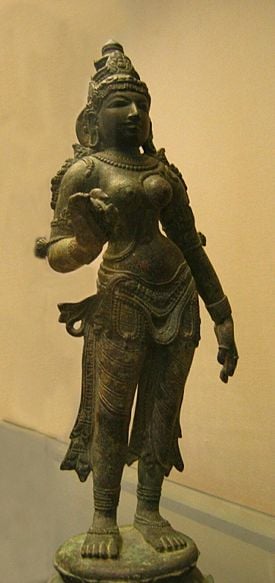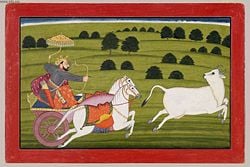Bhudevi
| ||||||||||
Bhuma Devi or Bhumi Devi or Bhu Devi (Sanskrit: "the goddess who is the earth") is an earth goddess and the divine wife of Varaha, an Avatar of Vishnu. Bhudevi is the Goddess of Earth, and the fertility form of Lakshmi. Prithvi is also called Dhra, Dharti, Dhrithri, meaning thereby, which holds everything. As Prithvi Devi, she is one of two wives of Lord Vishnu. His other wife is Lakshmi. Prithvi is another form of Lakshmi. Another name for Her is Bhumi or Bhudevi or Bhuma Devi. Bhudevi or related goddesses personifying the earth often accompany incarnations of Vishnu, and as such it is often the earth's call for help which triggers the descent of the sky god [1]
Mythology
Vedas
Bhudevi's Vedic precursor seems to have been Prithvi Mata (Sanskrit: "earth mother", the primordial goddess of the Rg Veda. One of the oldest Aryan dieties, she too personifies of the Earth while taking on the attributes of a loving mother. She shares many common traits with other Indo-European earth goddesses such as the Greek Gaia, in that she is personified as a mother and paired with a sky god Dyaus as her consort. In the Rigveda, Earth and Sky are frequently addressed in the dual, probably indicating the idea of two complementary half-shells. Together she and Dyaus are considered the creators of the myriad beings, and sired many divine children who became the progenitors of the rest of the Hindu pantheon. She is the mother of Indra, who eventually rose to become the supreme sky god, and Agni, the god of fire. Legend has it that when Agni was born, Prithvi and her husband fled away from the fiery diety in fear. According to another myth, when Indra killed Dyaus Pita for purposes of overthrowing him, Prithvi applauded his deed and then married him.
Prithvi is the source of all vegetation, bestowing prosperity upon the inhabitants of earth, and serves to represent the female principle. Hymns dedicated to her in the Rg Veda praise her for her sustaining fecudity as well as her incredible stability. In her associations with the gifts of plenty, she was commonly symbolized as a cow. Prithu, an incarnation of Vishnu, milked her in the cow's form to get food from her. The Vedic cult seems to have commemorated the earth and her giving properties in at least one ritual. Here, a cake made of newly harvested barley or rice mixed with clarified butter was offered to the Sky father and mother earth. The offering may also have consisted exclusively of clarified butter, as this was considered the sap of the heaven and earth. Regardless, Prithvi does not seem to have been attributed with the importance of the earth-mother goddesses in the Greek, European and European mythological traditions, which is not surprising considering the patriarchal focus of the Vedic Aryans.
Epics
In the Valmiki Ramayana, Rama's wife Sita is discovered in a plowed field by Janaka, king of Mithila. Hence, Sita is born ayonija — not from the womb of a woman but rather from the womb of the earth itself, and for that reason she has been regarded as a daughter of Bhudevi. Throughout the story, however, she becomes something of an earth goddess and therefore a representation of Bhudevi in her own right; after all, she is the incarnation of Sri-Lakshmi, who herself has been related to the bounty of the earth and Bhudevi. Sita, then, in the tradition of Bhudevi, inherits this mytheme of the fertile, feminine earth , which is fructified by the decidedly male power of the sky incarnate in the person of the titular hero.
In the Uttara-Kanda, the final book of the Ramayana, Rama banishes Sita to the forest due to unsubstantiated public suspicions that she may have compromised her chastity under captivity of the demon Ravana. Rama insists upon having Sita go through with the exile in spite of the fact that she has already survived the Agni pariksha — the harrowing task of walking through fire — in order to prove her chastity to him. Later on Rama realizes the error of his ways and eventually seeks out Sita in the forest, begging for her return to Ayodhya. At this point Sita requests that Bhudevi take her back, and she is promptly swallowed into a cleft in the soil, never to be seen again. Not only does this deus ex machina provides Sita with some measure of justice in the face of intense suffering, but it also reaffirm her status as daughter and incarnation of the earth mother.
Puranas
The Vishnu Purana provides an account of Prithvi/Bhudevi's birth. A notoriously evil king by the name of Vena began to neglect his religious duties, and was subsequently slain by a group of sages who had grown discontent with his impiety. In the wake of the king's death, anarchy ensued. The sages began to rub the thigh of Vena, and from where they rubbed there came forth a black dwarf, representing all of Vena's sin. Afterward, the asges rubbed Vena's right arm, and from it there emerged a resplendent prince named Prithu, who assume the throne held by his father. During his reign, the earth would not yield fruits, and so a terrible famine developed. Prithu vowed to slay the earth, thereby forcing her to give up her precious resources. Terrified, the earth assumed the form of a cow. Prithu gave chase to the beast, all the way to the heaven of Brahma. Finally, she turned to her pursuer and reminded him of the magnitude of sin that killing a woman entailed. The king replied that the murder of one for the benefit of many is a virtuous act. The earth retorted by noting that a kingdom without the earth would be utterly devoid of support. In order to make amends, the earth-as-cow agreed to use her milk to fertilize the dessicated landscape, so long as Prithu flattened the land so as to be conducive to the flow of the nourishing liquid. Prithu accepted the conditions, and had the land plowed up and smoothened, thus marking the beginning of agriculture. Prithu then milked the earth and his kingdom was able to ascend from their famine when all varities of corn and vegetables sprouted forth. Because Prithu was considered her father, the earth was given the epithet Prithvi.
According to the Puranas, Bhudevi is the consort of Varaha, Vishnu's third avatar. In the story of their pairing, Bhudevi takes on the role of the earth in its most literal, elemental form, while Varaha takes the form of a boar. When mother earth is carried off by asuras and submerged under the vast ocean by the orders of the demon Hiranyaksha, Varaha comes to her aid, diving deep down into the great waters. Here he kills Hiranyaksha and steadies Bhudevi on his snout, carrying her above the water once again. He then maps the geography of the land as we know it today, sculpting mountains and valleys, and dividing it into seven continents.
Bhudevi and Varaha parented Narakasura, who grew to become a powerful demon king, due in large part to a boon he received from Lord Brahma dictating that he could be killed by no being save for his mother. With his power, Narakasura mistreated the gods and accumulated a harem of women numbering in the tens of thousands. His tyrannical reign lasted many eons, and eventually Vishnu took birth again in order to save the universe at the request of the gods, this time as Krishna. Krishna took Satyabhama as his third wife, who has subsequently been labelled as an avatar of Bhudevi. When Satyabhama heard of the Narakasuara's mistreatment of women, particularly the godly matriarch Aditi, she became enraged. Krishna not only granted her his permission to fight the demonic despot, but he lent her Garuda as a mount. Satyabhama journeyed to the capital of Naraksura's kingdom along with her husband, and initiated a battle with her son. She proved no match for his martial training. Seeing his oppurtunity, Narakasura turned his attention to Krishna, wounding him with a surprise attack. Krishna fainted, reinvigorating the fury of Satyabhama. She attack her son with increased ferocity and finally debilitated him with a mortal blow. As Narakasura took his last breaths, he made one final request of his mother: that his death be commemorated annually with colourful lights. Thus, this mythological event is celebrated each year during Diwali, the festival of lights.
Iconography
Typical devotional pictures or statues depict Bhudevi as a shapely woman. Sometimes she is shown with four arms, and in many statues her skin is dark. She is usually heavily adorned with crown and jewels, an indication of her status as a queen in Vishnu's heavenly kingdom. One of the most common types of depictions pictures her with Vishnu as one of two forms of Lakshmi (the other being Sridevi) who sit on either side of the enthroned preserver god. In this role she personifies fertility, while Sridevi represents wealth and knowledge, the primary blessings bestowed by Lakshmi. Another common representation of Bhudevi places her at the side of her Puranic consort Varaha. In these sorts of images she is relatively small compared to the boar-god, and commonly he shown carrying her to safety atop his nose or in his arms.
Legacy
As an earth goddess, Bhudevi continues the lineage of the earth goddess, which has been a persistent element of Indo-European mythology as well as that of the entire world. This conceptualization of the earth as mother retains an element of the feminine in the Hindu religious experience, and has remained consistent throughout the history of the tradition: elements of Bhudevi have been present since Vedic times in the figure of Prthvi, and have continued on with other popular female figures such as Sita, Satyabhama and Lakshmi, all of whom bear elements of the earth goddess as well as connections with the sky god. This means by which to venerate the feminine has even manifest itself in the world of human religious experience. For example, Andal, a 10th century Tamil saint and the only female included among the Alvars, is herself considered to be a manifestation of Bhudevi, her hagiographies attributing her birth to the soil underneath a Basil plant.
Not only does Bhudevi represent the sacrality of the feminine, but also the immense organic significance of the physical earth itself. As David Kinsley has written: "An underlying implication of perceiving the earth as a great and powerful goddess is that the world as a whole, the cosmos itself, is to be understood as a great, living being, a cosmic organism."[2]
Notes
ReferencesISBN links support NWE through referral fees
- Dallapiccola, Anna. Dictionary of Hindu Lore and Legend. London: Thames and Hudson, 2002. ISBN 0-500-51088-1
- Kinsley, David. Hindu Goddesses: Vision of the Divine Feminine in the Hindu Religious Traditions. Berkeley: University of California Press, 1988. ISBN 978-0520063396
- Mani, Vettam. Puranic Encyclopedia. Delhi : Motilal Banarsidass, 1975. ISBN 0842608222
- Nagaran, Vijaya Rettakudi. "Soil as the Goddess Bhudevi in a Tamil Women's Ritual." In Women as Sacred Custodians of the Earth: Women, Spirituality and the Environment. Ed. Alaine Low and Soraya Tremayne. New York: Bergham Books, 2001. 159-174. ISBN 1-57181-467-1
Credits
New World Encyclopedia writers and editors rewrote and completed the Wikipedia article in accordance with New World Encyclopedia standards. This article abides by terms of the Creative Commons CC-by-sa 3.0 License (CC-by-sa), which may be used and disseminated with proper attribution. Credit is due under the terms of this license that can reference both the New World Encyclopedia contributors and the selfless volunteer contributors of the Wikimedia Foundation. To cite this article click here for a list of acceptable citing formats.The history of earlier contributions by wikipedians is accessible to researchers here:
The history of this article since it was imported to New World Encyclopedia:
Note: Some restrictions may apply to use of individual images which are separately licensed.

